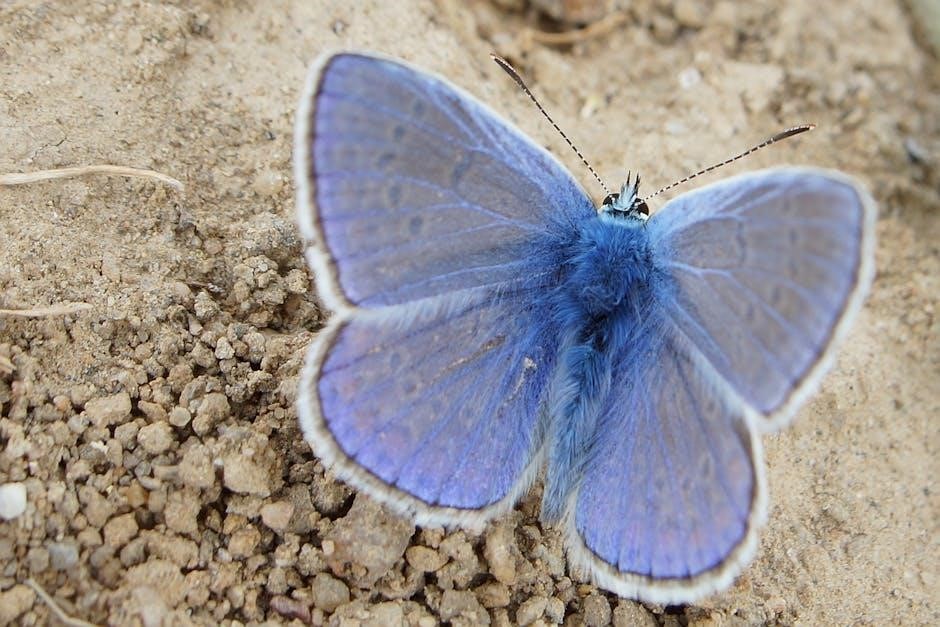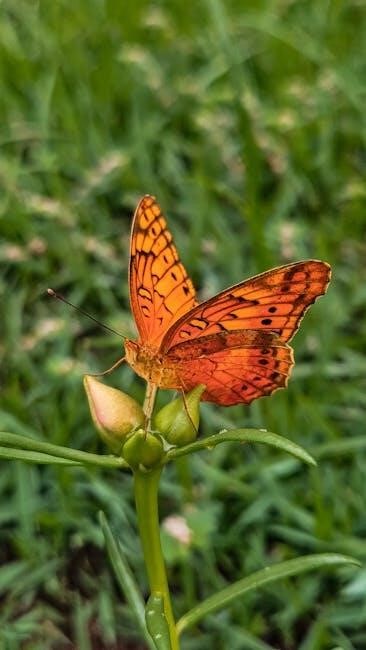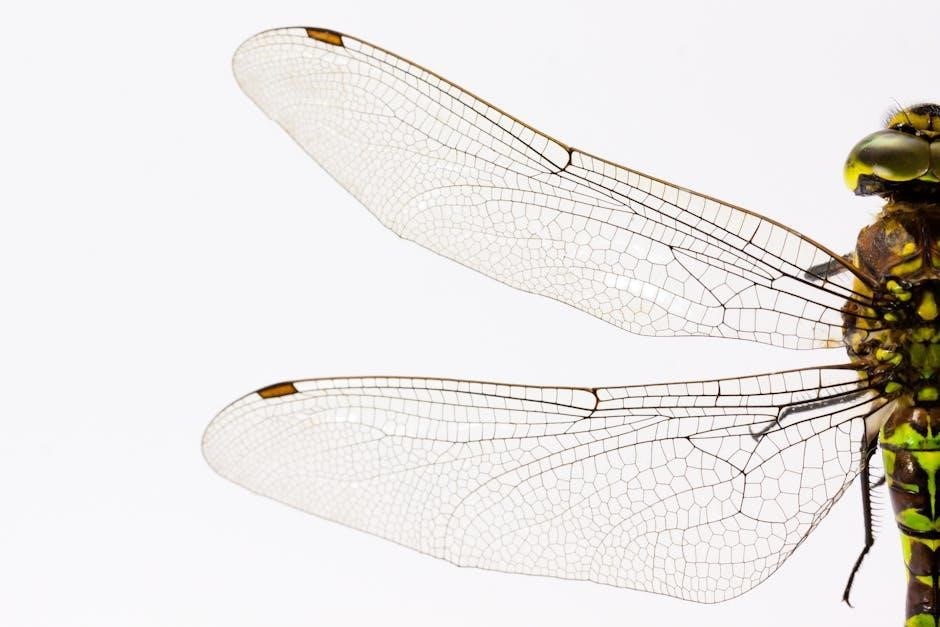Insect wings are diverse, with structures like tegmina, elytra, and membranous wings, each adapted for specific functions such as flight, protection, and signaling, showcasing evolutionary ingenuity.
Origin and Evolution of Insect Wings
The origin of insect wings dates back approximately 400 million years to the Devonian period. Early wing-like structures likely evolved as flap-like appendages, aiding in gliding and balance. These primitive forms gradually developed into more complex wings with venation patterns, enabling true flight. Fossil evidence suggests that the first wings were simple, without the advanced venation seen in modern insects. Over time, wings evolved to become highly specialized, with distinct types emerging to suit various ecological roles. The development of wing coupling mechanisms, such as those in beetles and grasshoppers, further enhanced flight efficiency. This evolutionary process was driven by the need for mobility, predator avoidance, and resource competition, making wings a cornerstone of insect success and diversity.
Basic Structure of Insect Wings
Insect wings are highly specialized appendages composed of a thin, flexible cuticle stretched between rigid veins. They originate from the meso- and meta-thoracic segments, forming forewings and hindwings. The wing structure includes a double-layered membrane with dorsal and ventral laminae. Venation patterns, formed by tubular structures containing nerves and tracheae, provide structural support and aid in flight. Key veins include the costa (leading edge), radius, median, cubitus, and anal veins. These features contribute to wing flexibility and strength. The surface area is divided into regions like the remigium and vannal area, which play roles in flight dynamics. This intricate design allows wings to function as lightweight yet durable organs, enabling flight, protection, and sensory functions, making them a critical adaptation in insect evolution and survival.

Types of Insect Wings
Insect wings vary widely, including tegmina, elytra, hemelytra, membranous, fringed, and haltere wings, each adapted for specific functions like flight, protection, and balance, reflecting evolutionary diversity.
Tegmina: Leathery and Protective Wings
Tegmina are leathery, non-flight forewings that protect the delicate membranous hind wings. Found in insects like cockroaches and grasshoppers, they are tough yet flexible, providing a defensive barrier. Their surface often features distinct venation patterns, aiding in identification. Tegmina are also adapted for sensory functions in some species. During flight, they remain folded, safeguarding the hind wings. This unique structure exemplifies evolutionary adaptations for dual-purpose wings, balancing protection and functionality. Tegmina are a key feature in understanding insect wing diversity and their specialized roles in survival and locomotion.
Elytra: Hard and Shell-like Wings
Elytra are hardened, shell-like forewings that protect the hind wings and abdomen in beetles. They form a rigid, horny covering without prominent venation. During flight, the elytra are lifted to allow the membranous hind wings to move. Their primary function is protection, safeguarding internal structures when the insect is at rest or burrowing. Elytra also play a role in thermoregulation and can display vibrant colors or textures for signaling. This adaptation is crucial for beetles, offering durability while allowing for efficient flight mechanics. The elytra’s structure and function highlight the evolutionary trade-offs between protection and mobility in insects. Their resilience makes them a key feature of beetle anatomy, enabling survival in diverse environments.
Hemelytra: Partially Hardened Wings
Hemelytra are partially hardened wings found in certain insects, such as true bugs (Heteroptera). They combine rigidity and flexibility, with the basal portion being leathery and the distal part membranous. This unique structure allows hemelytra to protect the hind wings while enabling flight. The hardened section provides durability, while the flexible part facilitates movement. Hemelytra often feature distinct venation patterns and are adapted for specific ecological roles, such as camouflage or signaling. Their dual nature makes them a fascinating example of evolutionary adaptation, balancing protection and mobility. This wing type is a key characteristic of bugs, reflecting their diverse lifestyles and environments. The hemelytra’s design underscores the functional diversity of insect wings, tailored to meet the survival needs of their bearers.
Membranous Wings: Thin and Flexible
Membranous wings are thin, flexible, and translucent, primarily found in insects like flies, bees, and butterflies. These wings are composed of a double layer of integument, supported by a network of veins that enhance strength and facilitate flight. Their flexibility allows for rapid wing movements, enabling precise control during flight. Membranous wings are often used as hind wings, complementing the protective forewings in some species. They are highly efficient for generating lift and thrust, making them crucial for agile flight. Their venation patterns vary, with distinct structures aiding in aerodynamics. This wing type exemplifies the evolutionary trade-off between protection and flight performance, emphasizing adaptability in various ecological niches. The membranous wing’s design is a testament to the intricate engineering of insect flight systems, optimized for both form and function.

Fringed Wings: Edged with Hair-like Structures

Fringed wings are characterized by a distinct edge lined with hair-like structures, providing enhanced aerodynamic performance. These wings are commonly found in insects such as lacewings, thrips, and some species of flies. The fringe, composed of fine hairs or setae, improves flight efficiency by reducing air resistance and enhancing lift. This adaptation is particularly beneficial for small insects, enabling precise maneuverability and stable flight. The fringed margin also serves as a protective feature, preventing wing damage during flight. Additionally, the unique structure of fringed wings aids in species identification and ecological adaptation, making them a specialized trait in insect wing diversity. This wing type highlights the evolutionary focus on optimizing flight performance through structural specialization.
Haltere Wings: Reduced and Balancing Organs
Haltere wings are highly specialized, reduced structures that function primarily as balancing organs rather than flight appendages. Found in certain insects like flies and some beetles, halteres are remnants of hind wings that have evolved into small, club-shaped or drumstick-like organs. These wings are non-flight-functional but play a critical role in maintaining equilibrium and stabilizing flight. Halteres act as gyroscopic sensors, detecting changes in flight dynamics and providing sensory feedback to the insect’s nervous system; Their movements are synchronized with the main wings, enabling precise flight control and orientation. Despite their reduced size, halteres are essential for insect flight efficiency and maneuverability, showcasing a remarkable evolutionary adaptation where form follows function in a highly specialized manner. This unique adaptation underscores the diversity and complexity of insect wing morphology.

Functional Morphology of Insect Wings
Insect wings consist of a double-layered membrane with veins, powered by thoracic muscles. Their structure ensures lift, thrust, and maneuverability, adapting to various flight demands and forces.
Vein Patterns and Their Significance
Insect wings feature intricate vein patterns categorized into primary and secondary venation; These venation patterns provide structural support, ensuring wing stability and flexibility during flight. The network of veins acts as a framework, allowing the wing membrane to maintain its shape under various aerodynamic forces. Different vein configurations are adapted to specific flight styles, such as rapid maneuvering or long-distance migration. The arrangement of veins also plays a role in controlling airflow, contributing to lift and thrust generation; Additionally, vein patterns can be used to identify insect species and understand their evolutionary relationships. The complexity and diversity of these patterns highlight the remarkable adaptability of insect wings to their environments and functional needs, making them a key area of study in entomology and aerodynamics.
Wing Coupling Mechanisms
Wing coupling mechanisms are specialized structures that ensure the proper alignment and synchronization of insect wings during flight. These mechanisms prevent the wings from separating and maintain aerodynamic efficiency. One common type is the hamulate coupling, where small hooks on the hind wings engage with the fore wings. Another is the amplexiform coupling, involving a fold or notch that locks the wings together. These systems vary across species, with some insects relying on overlapping wing edges or specialized muscles. For example, beetles use a tight overlap of their elytra and hind wings, while flies and bees employ a flexible joint that allows wing movement. These mechanisms are crucial for stable flight, enabling precise control and maneuverability. The diversity in coupling systems reflects the evolutionary adaptation of insects to their specific flight requirements and environments.
Evolution of Insect Wing Diversity
Insect wing diversity evolved through adaptations to environmental pressures and genetic factors, leading to specialized structures like tegmina, elytra, and membranous wings for varied flight and survival strategies.
Adaptations for Different Flight Styles
Insects have evolved specialized wing structures to suit various flight styles. Membranous wings, found in flies and mosquitoes, allow agile maneuverability and rapid wing movement. Tegmina, leathery forewings in grasshoppers, protect hind wings during flight, enabling powerful jumps and glides. Elytra in beetles are hardened wing covers that shield membranous hind wings, providing protection while still allowing flight. Fringed wings, with hair-like structures, enhance stability in smaller insects like thrips. Halteres, reduced wings in flies, act as balancing organs during flight. These adaptations reflect evolutionary pressures, optimizing flight efficiency, maneuverability, and survival in diverse environments. Wing venation patterns and shapes further influence aerodynamic performance, ensuring each insect’s flight style is uniquely suited to its ecological niche;
Specialized Wing Structures for Camouflage and Signaling
Insect wings often feature specialized structures for camouflage and signaling, enhancing survival and communication. Some wings exhibit intricate patterns or coloration that mimic leaves or flowers, blending seamlessly into environments. For example, the transparent wings of certain wasps and dragonflies reduce visibility, while others, like butterflies, display vibrant scales that signal toxicity or attract mates. Fringed wings in smaller insects, such as thrips, may also aid in blending with hairy vegetation. Additionally, wing venation patterns can create optical illusions, further aiding camouflage. These adaptations not only protect insects from predators but also play roles in mating and territorial behaviors, demonstrating the dual functionality of wing structures in both concealment and communication. Such specialized features highlight the evolutionary versatility of insect wings beyond their primary role in flight.
Insect wings represent a remarkable example of evolutionary adaptation, with diverse structures tailored to specific functions such as flight, protection, and communication. From the hardened elytra of beetles to the delicate membranous wings of flies, each type reflects unique ecological pressures and survival strategies. The intricate venation patterns, specialized coupling mechanisms, and adaptations like fringed or scaly wings highlight the complexity of these appendages. Beyond their primary role in flight, wings serve as tools for camouflage, mating, and environmental interaction, showcasing their multifunctional nature. The study of insect wings not only deepens our understanding of insect biology but also inspires technological innovations in fields like aerodynamics and materials science. Their diversity underscores the ingenuity of evolutionary processes, making insect wings a fascinating subject of scientific exploration and admiration.